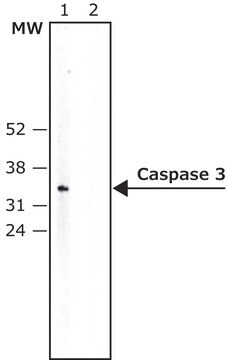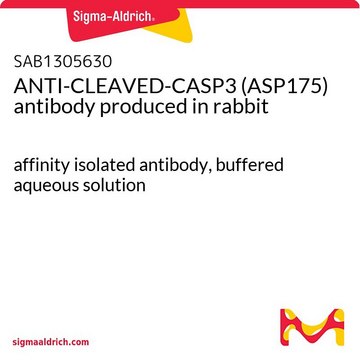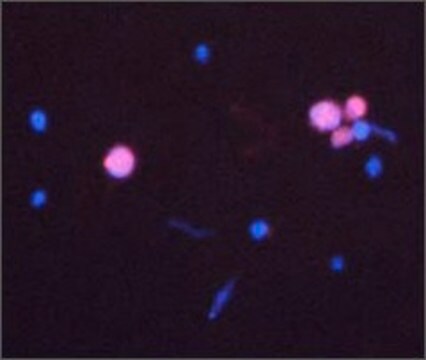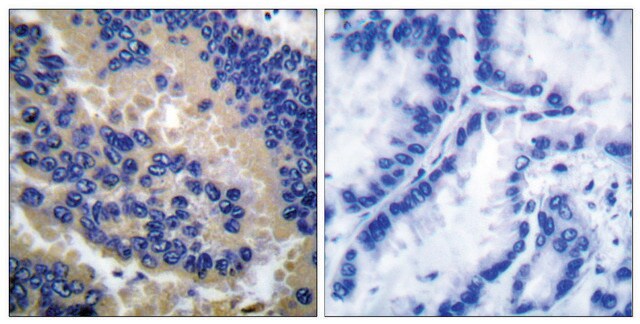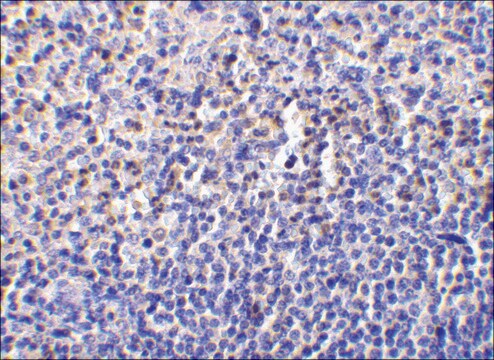AB3623
Anti-Caspase 3 Antibody, active (cleaved) form
Chemicon®, from rabbit
Synonim(y):
Apopain, Yama Protein, CASP3, SCA-1, procaspase3
About This Item
Polecane produkty
pochodzenie biologiczne
rabbit
Poziom jakości
forma przeciwciała
affinity isolated antibody
rodzaj przeciwciała
primary antibodies
klon
polyclonal
oczyszczone przez
affinity chromatography
reaktywność gatunkowa
mouse, rat, human
producent / nazwa handlowa
Chemicon®
metody
immunofluorescence: suitable
immunohistochemistry (formalin-fixed, paraffin-embedded sections): suitable
western blot: suitable
numer dostępu NCBI
numer dostępu UniProt
Warunki transportu
dry ice
docelowa modyfikacja potranslacyjna
unmodified
informacje o genach
human ... CASP3(836)
Opis ogólny
Specyficzność
Immunogen
Zastosowanie
Apoptosis & Cancer
Metabolism
Caspases
Enzymes & Biochemistry
1:100-1:200 (0.5-4 µg/mL) dilution of active apoptotic cells we used to detect Caspase-3.
Note when using tissue, levels of active caspase 3 can below detectable levels. Use CC119 (human caspase 3) incubated 30 minutes with 1 mM ATP (for activation) as a positive control on westerns. Alternatively, neuronal culture preparations incubated with staurosporine (0.5 µM, 10-18 hr) typically give a strong caspase 3 signal.
Immunohistochemistry:
1:10 dilution (10-20 µg/mL), AB3623 has reacted successfully in 4% PFA fixed, paraffin embedded tissues mouse tissues.
Immunohistochemistry(paraffin):
Optimal Staining of Caspase-3 Monoclonal Antibody: Mouse Small Intestine
Opis wartości docelowych
Powiązanie
Postać fizyczna
Przechowywanie i stabilność
Komentarz do analizy
Tonsil and appendix tissue. Jurkat cells induced for apoptosis with recombinant soluble TRAIL and staurosporine treated mouse 3T3 cell lysates Skin/Tumor, Embryo.
Inne uwagi
Informacje prawne
Oświadczenie o zrzeczeniu się odpowiedzialności
Nie możesz znaleźć właściwego produktu?
Wypróbuj nasz Narzędzie selektora produktów.
polecane
Hasło ostrzegawcze
Warning
Zwroty wskazujące rodzaj zagrożenia
Zwroty wskazujące środki ostrożności
Klasyfikacja zagrożeń
Aquatic Chronic 2 - Skin Sens. 1
Kod klasy składowania
10 - Combustible liquids
Klasa zagrożenia wodnego (WGK)
WGK 3
Certyfikaty analizy (CoA)
Poszukaj Certyfikaty analizy (CoA), wpisując numer partii/serii produktów. Numery serii i partii można znaleźć na etykiecie produktu po słowach „seria” lub „partia”.
Masz już ten produkt?
Dokumenty związane z niedawno zakupionymi produktami zostały zamieszczone w Bibliotece dokumentów.
Klienci oglądali również te produkty
Nasz zespół naukowców ma doświadczenie we wszystkich obszarach badań, w tym w naukach przyrodniczych, materiałoznawstwie, syntezie chemicznej, chromatografii, analityce i wielu innych dziedzinach.
Skontaktuj się z zespołem ds. pomocy technicznej

